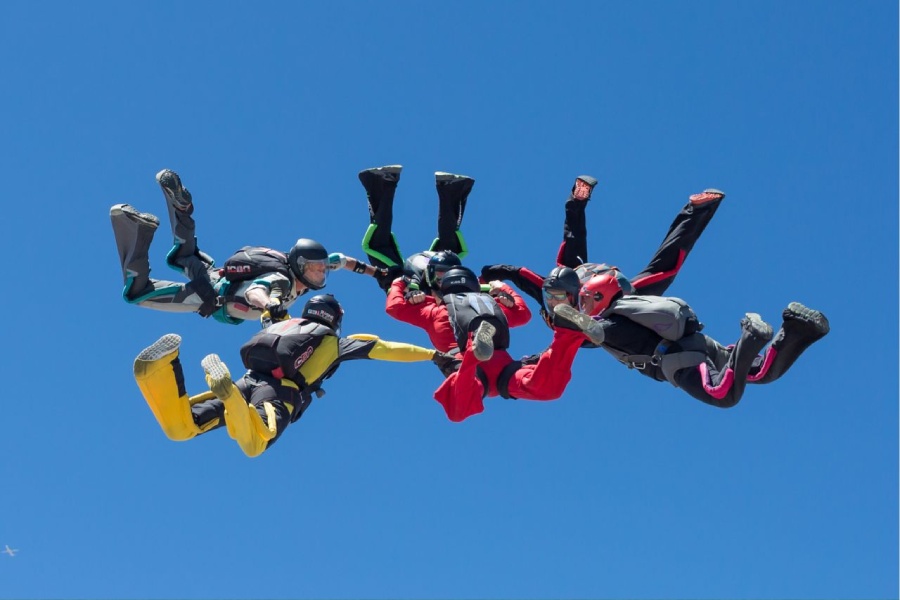High above Southern California, John Miller, 77, checked his altimeter. “We’re two miles up,” he shouted over the plane’s engines. “This is when everybody starts to get quiet.”
Sure enough, the cabin hushed as we reached altitude. Sharron Fielding, 70, squeezed my hand; Ricki Thues, 71, checked that his Santa hat was tied tightly under his chin. “Everybody ready?” called Doug Wuest, 69, their unofficial coach. “Ready, set, go!”
Wuest rolled up the aircraft door and, along with three friends, leaned out of the DHC-6 Twin Otter — 12,500 feet up. Then they let go.
Twenty-four other seniors followed, hurtling headfirst through the sky at 180 miles per hour.
They had about 45 seconds to get into position, manoeuvring into a three-ringed, lopsided snowflake, a formation that made the already daring jump even more challenging. Only two jumpers didn’t manage to attach in time.
At 5,500 feet, they broke apart and found safe distance from each other. Seconds later, they pulled their parachutes, 28 neon jellyfish drifting against the blue sky.
It was the first jump of the day for Wuest Ways, a group of older skydivers that Wuest and his wife, Marilyn, started in 1987. It was also their holiday party, held on a Sunday in early December, a chance to catch up and swap white elephant gifts.
For members, falling a couple of miles from a plane is a normal weekend activity, like watching a grandchild’s soccer game or heading to Costco. But they never get over the thrill. “When I exit the aircraft, it’s like I’m in my own world,” said Johnny Bateman, 80: He’s in the present moment, and dependent on himself for survival.
At the same time, the jumpers say, skydiving keeps them connected to the daredevil identities they forged in the wild early days of the sport. Bateman made his first jump in 1962, during his paratrooper training in the US Army. He stepped away from skydiving for decades, but he never let it go. “Every day, I was looking back up at the sky,” he said. “I knew I’d be back up there.”
A skydiving hobby requires more groundwork at 80 than at 20. Bateman stretches and exercises every morning and evening. Thues and his wife, Paula, 70, practise emergency manoeuvres every day, going through the hand motions to release a malfunctioning main parachute and open the reserve.
The sport also offers a sweet reward for ageing jumpers. “When you leave the airplane, there’s no arthritis, no aches and pains,” said Miller, whose jumpsuit sported badges earned for night jumping and a world record group formation. “It’s the most freeing thing you’ll ever do.”
Age brings new dangers, too. Dr Anna Lea, a general practitioner and skydiver who often does medical assessments for the sport around the world, told me she gives warnings to patients with heart problems and low bone density. But whether to jump is ultimately a personal choice, she said.
Injuries haven’t stopped Thues, who has returned to skydiving after neck fusion surgery and an ankle fracture. She doesn’t think about the risks much either, she said, she just makes sure to take precautions. “Besides, if you do anything, you might get hurt,” she added, dressed in bright pink from her bootees to her helmet. She’s right: One study found that the famously dangerous sport is actually safer than, say, surfing.
After reviewing footage of their first jump, Wuest made some adjustments to the lineup. He called everyone over for a so-called dirt dive — where the group practices the formation on the ground — to tighten the connections between the arms of the snowflake.
Lifelong skydivers are a close-knit community; Wuest Ways members also jump in Skydivers Over Sixty, Jumpers Over Seventy, Jumpers Over Eighty and Jumpers Over Ninety. And when their skydiving days end, their friendships continue.
For many, the sport has also accompanied the most meaningful chapters of their lives. Miller met his wife skydiving in the 1970s; their first kiss was in free-fall. He’s taken all his children and grandchildren up, and released the ashes of his two brothers and several friends on the way down.
Skydiving offers a clear-eyed perspective about how life ends. Many have friends who died in skydiving accidents. “You know in reality that any given day in the drop zone might be your last,” Miller said. “We’ve all had to look at our own mortality. We accept that if it’s your time, it’s your time.”
And indeed, it was almost time for Miller to swap his helmet for a Santa hat and head to the bar. But first — one last jump.











